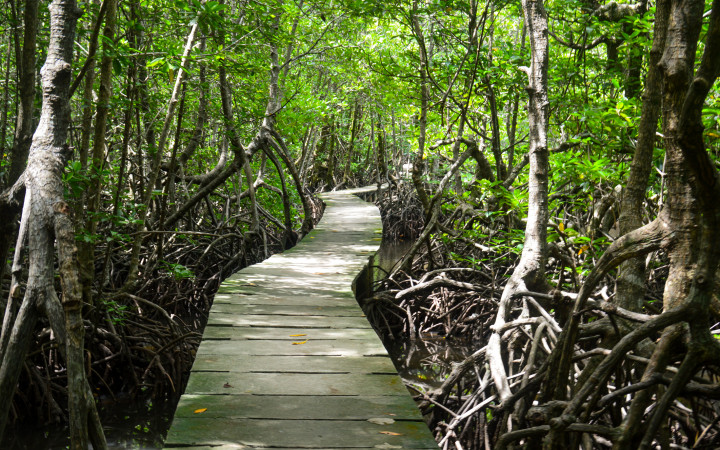Today’s Wonder of the Day was inspired by Emily. Emily Wonders, “What is a mangrove?” Thanks for WONDERing with us, Emily!
Our planet is full of amazing habitats. You might already know about the animals that live in Challenger Deep. Maybe you’ve learned about the ecosystem of the Great Barrier Reef, as well. The topic of today’s Wonder of the Day is also home to many species of wildlife. It’s a very special type of tree—the mangrove!
The mangrove isn’t just any tree. Mangroves are unique because of where they live. You’ll find these special plants on tropical and subtropical coastlines. Unlike other trees, they can thrive in salt-rich, oxygen-poor soil.
This is important for mangroves that live right on the coast. They’re flooded with salt water twice a day when the tide comes in. These trees have filtration systems that allow them to grow in this habitat. Some species filter out salt before it enters the plant. Others secrete the salt they take in through their leaves.
How many species of mangrove trees exist? Experts disagree. The lowest estimate is 54. However, some say that 80 different species trees fit under the mangrove umbrella.
Often, many types of mangroves grow together in large clusters. This is called a mangrove forest. The plants in this type of forest can vary. Some species will grow to be over 130 feet tall, while others stay the size of small shrubs.
Mangroves’ long roots reach underwater to the ground. They help to shelter fish and other wildlife from predators. They also provide a safe place to lay eggs. For that reason, a variety of animals build homes in this habitat. You’ll find birds, insects, monkeys, and sloths in mangrove branches. Near the water, there are crabs, snails, and worms. You’ll also see sponges, barnacles, oysters, shrimp, and many types of fish. Mangrove forests provide food and shelter for many animals, including some endangered species.
Many people don’t realize that mangroves also play an important role in fighting climate change. They store huge amounts of carbon, keeping it out of the atmosphere. Mangroves use carbon to help their leaves and branches grow. When leaves fall from the trees, they end up on the ocean floor.
This is called carbon burial—because the carbon ends up buried beneath the seafloor. Mangroves are responsible for 10-15 percent of carbon burial. That’s impressive, since they only make up about two percent of water habitats. Globally, mangrove forests only cover between 53,000 and 77,000 square miles (138,000-200,000 square km).
Have you ever visited a mangrove forest? If you’d like to, you’re in luck! You’ll find mangroves along most of the world’s coasts. The most diverse forests grow in Southeast Asia, where experts say the trees originated. They believe the ocean currents carried mangrove seeds from Asia to the rest of the world. Some of the tallest trees grow in South America. There are twelve species of the trees in the Americas. They are also present in India, Africa, and Australia. It’s very important to protect these beautiful and diverse ecosystems.
Standards: NGSS.LS1.A, NGSS.LS1.C, NGSS.LS2.A, NGSS.LS4.C, NGSS.LS4.D, CCRA.R.4, CCRA.L.3, CCRA.L.6, CCRA.R.1, CCRA.R.2, CCRA.R.10, CCRA.SL.1, CCRA.SL.2, CCRA.W.2, CCRA.L.1, CCRA.L.2




